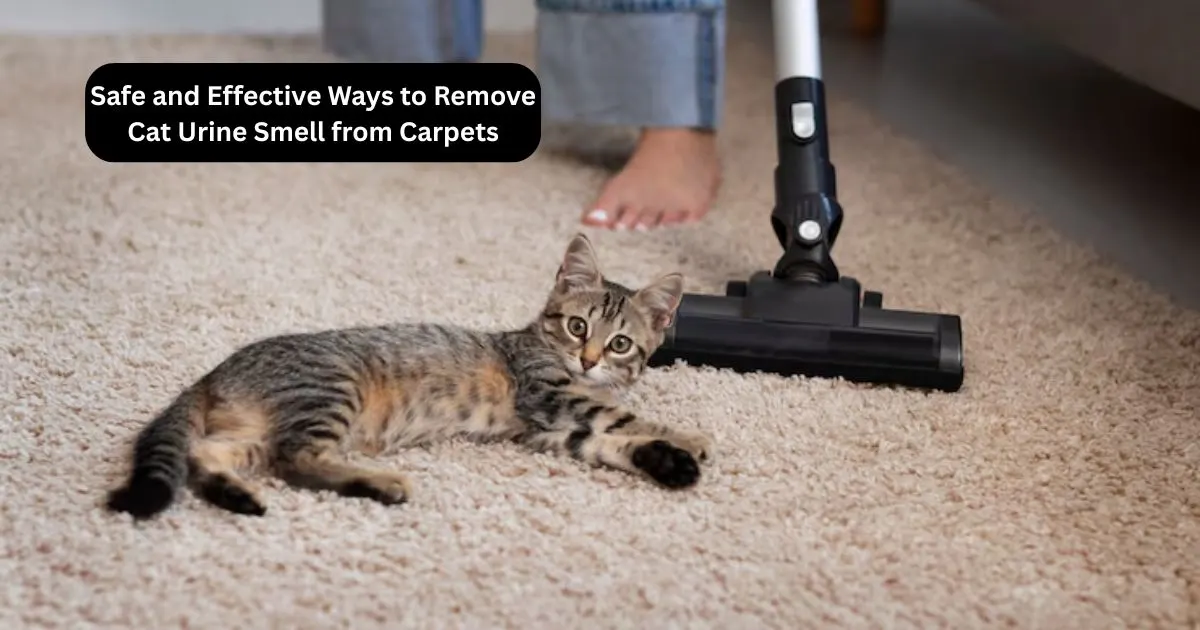Cats are wonderful companions, but accidents happen, and one of the most challenging pet-related issues is dealing with cat urine smell on carpets. Not only is the odor unpleasant, but the stain itself can linger, making your home feel less inviting.
Thankfully, with the right methods and tools, you can safely and effectively eliminate both the smell and the stain. In this article, we’ll guide you through proven strategies to handle this issue, answer common questions, and provide a helpful table of cleaning solutions.
Understanding Cat Urine Odor
Cat urine contains ammonia, uric acid, and other compounds that contribute to its strong smell. Uric acid is particularly stubborn because it can bind to carpet fibers and resist traditional cleaning methods.
If not thoroughly cleaned, the smell may persist, and your cat might return to the same spot, thinking it’s their designated area.
Steps to Remove Cat Urine Smell from Carpets
Step 1: Act Quickly
The sooner you address the mess, the easier it will be to remove the stain and odor. Fresh urine is simpler to clean than dried or older stains, which may have soaked deep into the carpet fibers.
Step 2: Blot, Don’t Scrub
Use paper towels or a clean cloth to blot up as much urine as possible. Avoid scrubbing, as it can spread the stain or push the urine deeper into the carpet. Gently press the area to soak up the liquid.
Step 3: Use an Enzymatic Cleaner
Enzymatic cleaners are specifically designed to break down the proteins and uric acid in cat urine. They eliminate the odor at the source rather than masking it. Apply the cleaner liberally to the affected area and let it sit for the recommended time before blotting it dry.
Step 4: Baking Soda and Vinegar
For a natural cleaning solution, mix equal parts white vinegar and water and apply it to the stain. Vinegar neutralizes the ammonia in cat urine. After blotting the area, sprinkle baking soda over it to absorb moisture and odors. Allow the baking soda to dry completely, then vacuum it up.
Step 5: Try Hydrogen Peroxide
If the stain persists, use a 3% hydrogen peroxide solution mixed with a small amount of dish soap. Apply this solution to the stain and let it sit for a few minutes before blotting. Test a small area of your carpet first to ensure the peroxide won’t cause discoloration.
Step 6: Steam Cleaning
For deep-seated odors, consider steam-cleaning the carpet. Use a carpet cleaner that works with water and an enzymatic cleaning solution for the most effective results. Steam helps lift the urine particles from the carpet fibers.
Step 7: Prevent Future Accidents
Once the area is clean, deter your cat from returning to the same spot by using pet-safe repellents or placing a litter box nearby. Thorough cleaning will prevent the smell from attracting your cat back to the area.
Table: Cat Urine Cleaning Solutions
|
Cleaning Solution |
Purpose |
Usage Tips |
| Enzymatic Cleaner | Breaks down proteins and uric acid | Follow product instructions carefully |
| Baking Soda and Vinegar | Neutralizes ammonia and absorbs odors | Test on a small area before full use |
| Hydrogen Peroxide Solution | Lifts stubborn stains | Avoid use on dark-colored carpets |
| Steam Cleaning Machine | Deep cleaning for persistent odors | Use with enzymatic cleaning solutions |
| Paper Towels or Cloth | Removes fresh urine | Blot gently, avoid scrubbing |
Tips for Maintaining a Clean and Odor-Free Carpet
- Regular Litter Box Cleaning Cats may urinate outside the litter box if it’s dirty or unappealing. Clean the litter box daily and ensure it’s placed in a quiet, accessible location.
- Spot Cleaning After Accidents Keep a cleaning kit handy with supplies like enzymatic cleaners, cloths, and a spray bottle. Prompt spot cleaning prevents odors from setting in.
- Professional Carpet Cleaning If the odor persists despite your efforts, consider hiring professional carpet cleaners who specialize in pet stains.
- Protect Your Carpet Use area rugs or mats in high-traffic areas to protect your carpets. These can be easily cleaned or replaced if an accident occurs.
- Monitor Your Cat’s Health Urinating outside the litter box could be a sign of stress, illness, or a urinary tract problem. If this behavior continues, consult a veterinarian.
FAQs: Cat Urine and Carpet Care
Q1. Why does cat urine smell so strong?
Cat urine contains ammonia and uric acid, which produce a strong odor. If not properly cleaned, the uric acid can crystallize and remain embedded in the carpet fibers, causing the smell to linger.
Q2. Can I use regular household cleaners to remove cat urine?
While household cleaners can remove surface stains, they often fail to neutralize uric acid and ammonia. Enzymatic cleaners are more effective for breaking down these compounds.
Q3. Is it safe to use vinegar and baking soda on carpets?
Yes, vinegar and baking soda are safe and natural cleaning solutions. However, always test them on a small area of your carpet first to ensure they won’t cause discoloration.
Q4. How do I stop my cat from urinating on the carpet?
Ensure your cat’s litter box is clean and in an accessible location. Address any behavioral or health issues by consulting a veterinarian. Use pet-safe repellents to discourage urinating in specific areas.
Q5. Can I steam clean my carpet after using an enzymatic cleaner?
Yes, steam cleaning can enhance the effectiveness of enzymatic cleaners by removing any remaining particles from the carpet fibers. Ensure the carpet is thoroughly rinsed and dried afterward.
Final Thoughts
Removing cat urine smell from carpets may seem daunting, but with the right approach, it can be done safely and effectively. By using enzymatic cleaners, natural solutions like vinegar and baking soda, and proper cleaning techniques, you can tackle even the toughest stains and odors.
Preventative measures, such as maintaining a clean litter box and addressing your cat’s behavior, will reduce the likelihood of future accidents.
